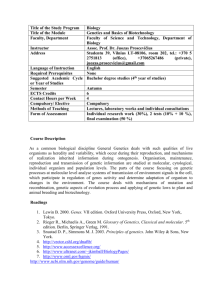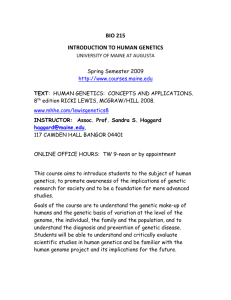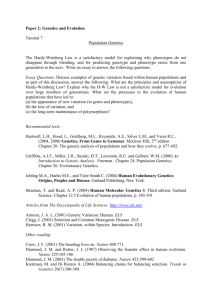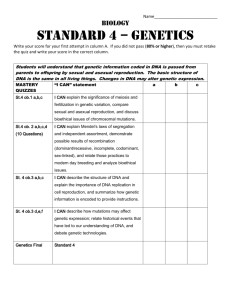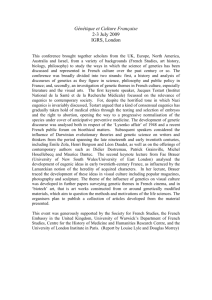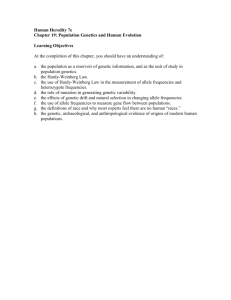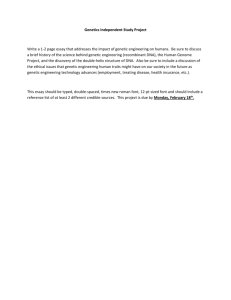Tutorial1
advertisement
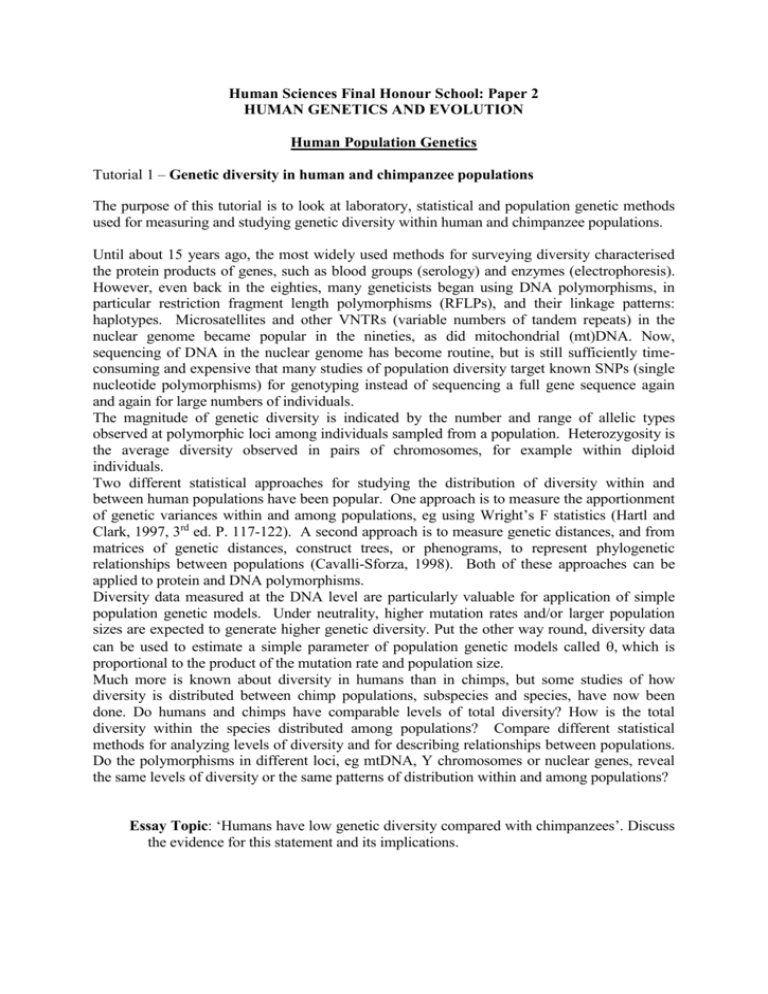
Human Sciences Final Honour School: Paper 2 HUMAN GENETICS AND EVOLUTION Human Population Genetics Tutorial 1 – Genetic diversity in human and chimpanzee populations The purpose of this tutorial is to look at laboratory, statistical and population genetic methods used for measuring and studying genetic diversity within human and chimpanzee populations. Until about 15 years ago, the most widely used methods for surveying diversity characterised the protein products of genes, such as blood groups (serology) and enzymes (electrophoresis). However, even back in the eighties, many geneticists began using DNA polymorphisms, in particular restriction fragment length polymorphisms (RFLPs), and their linkage patterns: haplotypes. Microsatellites and other VNTRs (variable numbers of tandem repeats) in the nuclear genome became popular in the nineties, as did mitochondrial (mt)DNA. Now, sequencing of DNA in the nuclear genome has become routine, but is still sufficiently timeconsuming and expensive that many studies of population diversity target known SNPs (single nucleotide polymorphisms) for genotyping instead of sequencing a full gene sequence again and again for large numbers of individuals. The magnitude of genetic diversity is indicated by the number and range of allelic types observed at polymorphic loci among individuals sampled from a population. Heterozygosity is the average diversity observed in pairs of chromosomes, for example within diploid individuals. Two different statistical approaches for studying the distribution of diversity within and between human populations have been popular. One approach is to measure the apportionment of genetic variances within and among populations, eg using Wright’s F statistics (Hartl and Clark, 1997, 3rd ed. P. 117-122). A second approach is to measure genetic distances, and from matrices of genetic distances, construct trees, or phenograms, to represent phylogenetic relationships between populations (Cavalli-Sforza, 1998). Both of these approaches can be applied to protein and DNA polymorphisms. Diversity data measured at the DNA level are particularly valuable for application of simple population genetic models. Under neutrality, higher mutation rates and/or larger population sizes are expected to generate higher genetic diversity. Put the other way round, diversity data can be used to estimate a simple parameter of population genetic models called which is proportional to the product of the mutation rate and population size. Much more is known about diversity in humans than in chimps, but some studies of how diversity is distributed between chimp populations, subspecies and species, have now been done. Do humans and chimps have comparable levels of total diversity? How is the total diversity within the species distributed among populations? Compare different statistical methods for analyzing levels of diversity and for describing relationships between populations. Do the polymorphisms in different loci, eg mtDNA, Y chromosomes or nuclear genes, reveal the same levels of diversity or the same patterns of distribution within and among populations? Essay Topic: ‘Humans have low genetic diversity compared with chimpanzees’. Discuss the evidence for this statement and its implications. General reading: Hartl, D.L. and Clark, A.G. (1997) Principles of Population Genetics. Sinauer. (Chapter 1: Genetic and statistical background; Chapter 2: Genetic and phenotypic variation; Chapter 4: Population substructure). Jobling, M.A., Hurles, M.E., and Tyler-Smith, C. (2004) Human Evolutionary Genetics: Origins, Peoples and Disease. Garland Publishing, New York. Chapter 7. Diamond, J. (1991) The Rise and Fall of the Third Chimpanzee. Radius. Chapter 1. Hey, J. and Machado C.A. (2003) The study of structured populations – new hope for a difficult and divided science. Nature Reviews Genetics 4 (July): 535-543. Pääbo, S. (2003) The mosaic that is our genome. Nature (23 January) 421:409-412. Relethford, J.H. (2003) Reflections of Our Past. Westview Press, Colorado, USA. Chapter 5 Scheffrahn, W., Brandt-Casadeval, C., and Kratzer, A. (2002) Human Population Genetics in a Primatological Context. Evolutionary Anthropology, Suppl 1:171-174 The following essays are from the Encyclopedia of Life Science, http://www.els.net/ Harrison, R.M. (2001) Variation, Within Species: Introduction. ELS Takahata N. (2001) Molecular Evolution: Neutral Theory. ELS Wade, M.J. (2002) Population Structure. ELS Variation within and between human populations: Lewontin, R.C. (1972) The apportionment of human diversity. Evolutionary Biology 6:381-398. Barbujani, G., Magagni, A., Minch, E. and Cavalli-Sforza, L.L. (1997) An apportionment of human DNA diversity. Proceedings of the National Academy of Sciences, USA 94:4516-4519. Brown, R.A. and Armelagos G.J. (2001) Apportionment of racial diversity: a review. Evolutionary Anthropology 10:34-40. Human diversity at the DNA level: Kaessmann, H., Heiig F, von Haeseler A. and Pääbo, S. (1999) DNA sequence variation in a non-coding region of low recombination on the human X chromosome. Nature Genetics 22:78-81. Li, W.-H. and Sadler, L.A. (1991) Low nucleotide diversity in man. Genetics 129:513-523. Przeworski, M., Hudson, R.R. and Di Rienzo, A. (2000) Adjusting the focus on human variation. Trends in Genetics 16(7): 296-302. Yu, N., Zhao, Z., Fu Y.-X., Sambuughin, N., Ramsay, M., Jenkins, T., Leskinen, E., Patthy, L., Jorde, L.B., Kuromori T., and Li, W.-H. (2001) Global patterns of human DNA sequence variation in a 10-kb region on Chromosome 1. Molecular Biology and Evolution 18(2):214-222 Yu, N., Chen, F.-C., Ota, S., Jorde, L.B., Pamilo, P., Patthy, L., Ramsay, M., Jenkins, T., Shyue, S.-K., and Li, W.-H. (2002) Larger genetic differences within Africans than between Africans and Eurasians. Genetics 161:269-274. Chimp diversity studies: Kaessmann, H., Wiebe, V. and Pääbo, S. (1999) Extensive sequence diversity among chimpanzees. Science 286:1159-1162. Gagneux, P. et al. (1999) Mitochondrial sequences show diverse evolutionary histories of African hominoids. Proceedings of the National Academy of Sciences, USA 96:50775082. Gagneux P. (2002) The genus Pan: population genetics of an endangered outgroup. Trends in Genetics 18(7): 327-330 Morin, P.A., Moore, J.J., Chakraborty, R., Jin, L., Goodall, J. and Woodruff, D.S. (1994) Kin selection, social structure, gene flow, and the evolution of chimpanzees. Science 265:1193-1201 Human-Chimpanzee differences: Cyranoski D. (2002) Chimpanzee genome: Almost human… Nature 418:910-912. Deeb, S. S., Jorgensen, A. L., Battisti, L., Iwasaki, L., and Motulsky, A. G. (1994) Sequence divergence of the red and green visual pigments in great apes and humans. Proceedings of the National Academy of Sciences, USA 91:7262-7266. Gagneux, P. and Varki, A. (2001) Genetic differences between Humans and Great Apes. Molecular Phylogenetics and Evolution 18(1):2-13 Gu, J. and Gu, X. (2003) Induced gene expression in human brain after the split from chimpanzee. Trends in Genetics 19(2):63-65 Hacia, JG (2001) Genome of the apes. Trends in Genetics 17(11):637-645. Kaessmann, H. and Pääbo, S. (2002) The genetical history of humans and great apes. Journal of Internal Medicine 251:1-18 Olson, M.V. and Varki A. (2002) Sequencing the chimpanzee genome: insights into human evolution and disease. Nature Reviews Genetics (Jan) 4:20-28. Wildman, D. E., Uddin, M., Liu, G., Grossman, L. I., and Goodman, M. (2003) Implications of natural selection in shaping 99.4% nonsynonymous DNA identity between humans and chimpanzees: Enlarging genus Homo. Proceedings of the National Academy of Sciences, USA 100:7181-7188.

